The world to reverse is the official August 2006 English translation of a March Japanese freeware visual novel of the same name. To be precise, the world of reverse is a two-part project containing a pair of short, distinct visual novels created by circle 17. It is structurally similar to another translated pair of novels from 17 that I reviewed and that was translated in 2005, I, Too, Saw Dreams Through Air.
The first novel in The world to reverse is hallucinate:
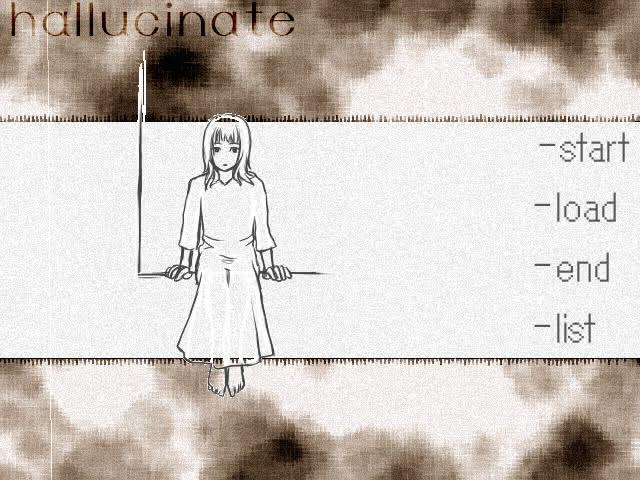
The second is Flanca:
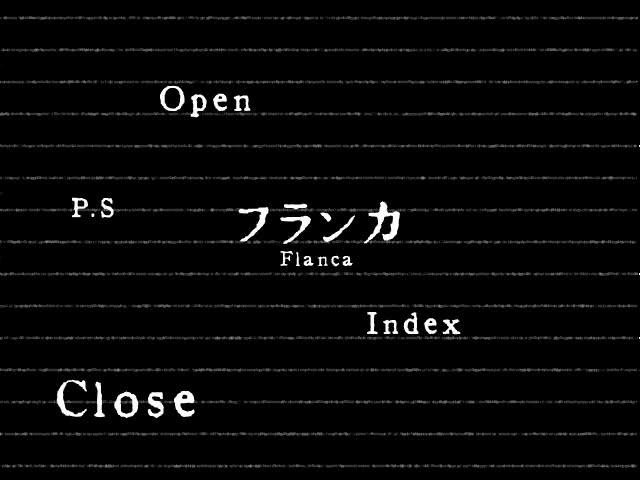
I am reviewing The world to reverse as part of my project to review nearly all of the 31 freeware Japanese visual novels translated into English for the 2005, 2006, and 2008 al|together festivals.
You can learn more about my al|together project by reading my project introduction article. That article includes a running list of our completed al|together reviews. I have a dedicated collection post with links to all of our al|together articles, including reviews, essays, and short posts.
The novels, hallucinate and Flanca are not related to one another beyond being created by the same circle for the same project. The first novel, hallucinate is a creepy story featuring a bedridden protagonist and a mysterious red-eyed girl who seems to hate him very much. Flanca is an entirely text-based adventure set in what appears to be a fictional area based on Medieval Europe, ridden with plague and castrated boys performing at the local theater. As one may infer from these descriptions, the material of The world to reverse is heavier than most of the al|together set and it comes with a recommendation that it is intended for readers aged 15 and up.
The world to reverse details
English version
| Title | The world to reverse. |
| Translator | satsu |
| Release Date | August 19, 2006 |
| Engine | ONScripter-EN (custom) |
| Official Website | al|together 2006 |
Japanese original
| Title | The world to reverse. |
| Developer | 17 |
| Notes | hallucinate is written by Yuki, Flanca is written by Ritsu |
| Original Release | March 31, 2006 |
| Engine | NScripter |
| Official Website | 17; Official Download |
Additional notes and links
The world to reverse is also available as a direct download from Kaisernet and Misanthropop.
Some issues running The world to reverse
The Japanese version of The world to reverse is written in NScripter, which is true of most of the novels that were translated for al|together (including 17’s other words, Adagio and I, too, saw dreams through air). The English translation was written and coded with a customized version of ONScripter (the source can be downloaded from the al|together 2006 site).
Because I run Linux, I always try to run al|together novels with one of the newer versions of ONScripter-EN, either a 2011 build or the new, currently maintained version. I have explained how to run ONScripter-EN games natively on Linux and how to extract the contents of a Windows ONScripter .exe file to do so.
However, I ran into a couple of issues with The world to reverse which led to my ultimately running the original 2006 Windows version on top of WINE.
The first of the two novels, hallucinate, has some interesting visual effects and uses MIDI (long the bane of my ONScripter-EN adventures) for its sound. Everything except the sound worked when I ran it with newer versions of ONScripter-EN (the original Linux build does not work on my system). I used the same MIDI set-up that has worked for most other native Linux ONScripter-EN novels, but I could not get sound in hallucinate. However, I will note that hallucinate only has a single sound track, so in theory one could play it in the background while enjoying the native Linux version of the game.
Flanca has no music at all, so sound was not a concern. However, the text display for choices was a bit off when running it with a newer ONScripter-EN build. The choices are supposed to appear beneath the preceding text. However, with a recent ONScripter-EN version, the choice replaces the preceding text.
After fiddling with it a bit, I decided to run the original Windows versions hallucinate and Flanca on top of WINE. Here, I had one minor issue involving sound skilling with a Lutris build of WINE, but both ran perfecting with Wine Staging 8.10. No additional set-up was required.
I will update this section if some of the issues with The world to reverse are resolved in subsequent ONScripter-EN releases. For the time being, I recommend running the original Windows version (either natively or on top of WINE).
General overview of The world to reverse.
The two novels which make up The world to reverse do not share a story, common theme, or aesthetic style. For that reason, I will generally discuss them separately. Due to how they are written, I will be very limited in what I say about the stories in order to avoid spoilers.
The first of the two novels is hallucinate. The al|together 2006 festival page described it as follows:
hallucinate, the world within: a spite-filled girl, a cruel white room, an unspeakable crime.
This is simultaneously vague and accurate. The player takes the role of a man waking up in a white room. He is missing a leg. The man is routinely visited by a red-eyed woman who hates him and asks him why he did not die. She seems to have good reason for hating him, but the man cannot remember. A single eerie song plays throughout.
The al|together 2006 festival page describes Flanca as follows:
Flanca, the world without: the boy backstage, the forgotten bouquet, the man in black, the painter.
The Flanca description is vague and accurate, but vague to the point of revealing almost nothing about Flanca. Flanca is an entirely text-based adventure with no visuals (beyond the background and text styling) and no music. The player takes the role of an unknown boy in what seems to be an unnamed Medieval-inspired European town at a date uncertain. Depending on his choices, he may bethe boy who plays the role of Flanca, the person who lost a bouquet, the man in black, or the painter on the bridge. The scenario in each case is dark, and the boy’s prospects are bleak. We learn generally that the theater utilizes eunuchs and there is a disease spreading through one half of the village turning residents into amputees.
The world to reverse review
I led off my review of 17’s I, Too, Saw Dreams Through Air by noting that “I was half-inclined” to review its two halves separately. One could argue that The world to reverse’s halves, united only by their bleakness, are even more different from one another than are the two halves of Dreams Through Air. However, the games were packaged together, so I will review them as two halves of a unified piece.
Estimated reading time
Both haves of The world to reverse are short. The current Visual Novel Database estimate of about 30 minutes combined seems about right. Flanca is definitely the longer of the two. I will add two notes of caution to the estimate. Firstly, because both novels employ choices (discussed below), one may spend a bit extra time keeping track of choice trees in order to see all of the scenes (this is most relevant to Flanca). Secondly, Flanca is a bit dense and may warrant multiple readings of certain sequences in order to piece the story together.
But, however you slice it, The world to reverse is short even when combining its two halves.
Game-play and structure
Both hallucinate and Flanca (especially Flanca) have multiple choices and paths.
hallucinate structure
hallucinate presents the player with two choices. The choices correspond to how the player feels about the terrible things that the haunting red-eyed girl says to him.
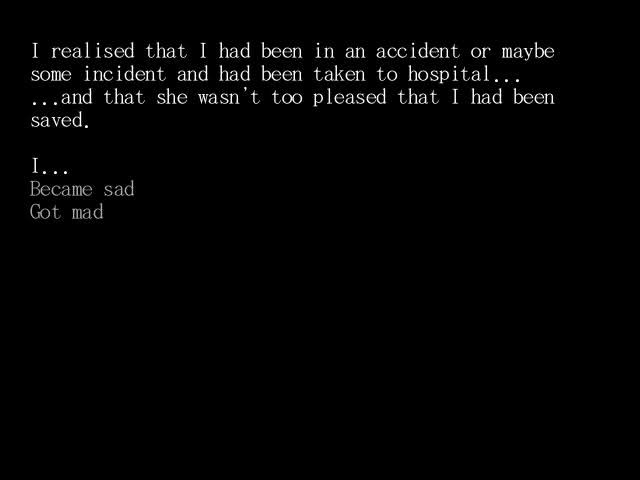
hallucinate has four endings based on the choices that the player makes. Each of the four possible choice combinations corresponds to a different ending. While hallucinate does not distinguish between its endings, one of the four endings reveals the story’s twist and changes the title screen. I will say that it is not immediately obvious which combination of choices leads to the most revealing ending.
(Note: You can see the four endings as you unlock them in the “list” menu on the title page. I decided not to include a screen capture for non-spoiler reasons. I also left out at least two tags which would have been fitting to avoid alluding to spoilers.)
Other than the choices, the game-play of hallucinate is limited to advancing the text.
Flanca structure
Flanca has 16 choices and 16 endings. On any given reading, the player will make four choices and reach one of 16 endings.

Flanca is a branching path novel. Each choice leads to a different scene and different possible endings. Each ending follows a definite sequence of four choices. After the first choice, there are 8 possible endings. After the second choice, there are four possible endings. After the third choice, there are two possible endings. The final choice determines the ending. It includes a convenient menu screen showing all of the scenes and paths and allowing the reader to re-read any particular scene by clicking on it.
Four of the sixteen endings unlock extra scenes (accessible from the main menu), and there is an additional extra scene for the player view-point character.
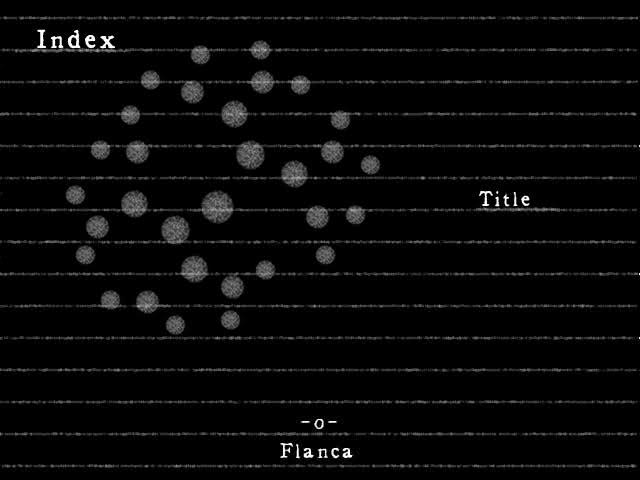
Flanca reads almost like a very short choose-your-own -adventure game. It has four major characters (as suggested in the al|together 2006 intro), and most of the endings reveal a bit about one of those four characters. A few endings focus more on the unnamed view-point character.
Flanca has no interactive elements other than making choices.
Visual presentation
Taken together, this section will be short since the latter half of The world to reverse has few visuals to speak of.
hallucinate visuals
The variety visuals in hallucinate are limited, but its small selection of visuals is striking, and the visuals stand out for uniqueness.

The backgrounds, which typically feature the view-point character’s hands or the woman who hates him, are hand-drawn and well done. They are overlaid with interesting film effects giving the feeling of something being run through a movie projector – an effect unique to the al|together set.
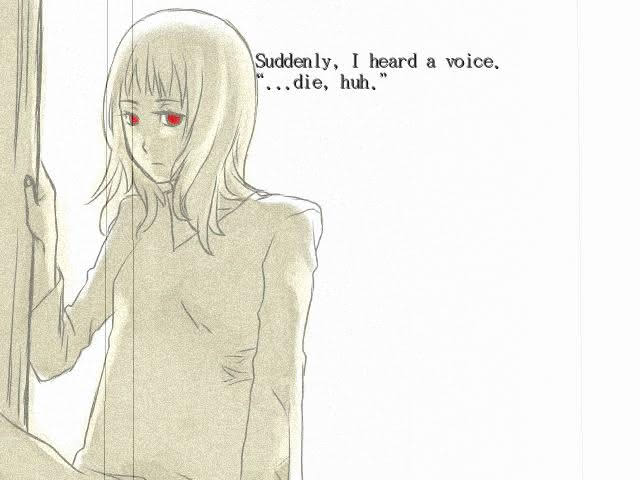
The red-eyed woman is the stand-out visual from hallucinate, but we also have at least one nice blue sky which reminds one of 17’s prior work in The Caged Vagrant.
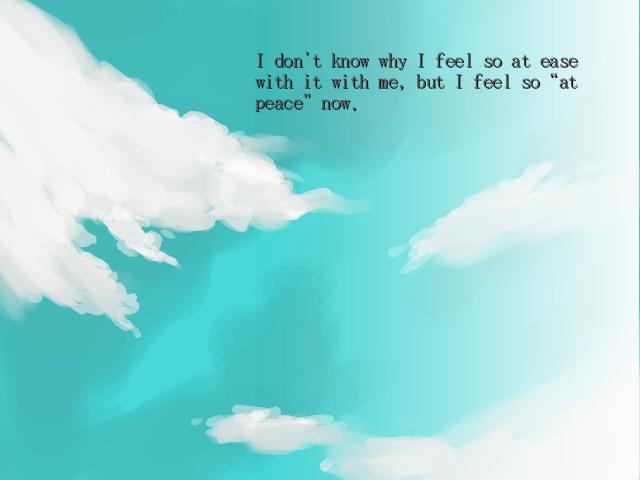
Finally, I did like the way the text was confined to a specific spot on the screen instead of the typical NScripter-style of having it cover the entire image.
While hallucinate is short, it leaves a definite impression with its haunting, theme-appropriate and high quality backgrounds.
Flanca visuals
Flanca is the most minimal visual production of al|together. Its “visuals,” as they are, consist entirely of a black background with lines (reminding one of lined paper) and text within the lines. The choices also appear within the lines.
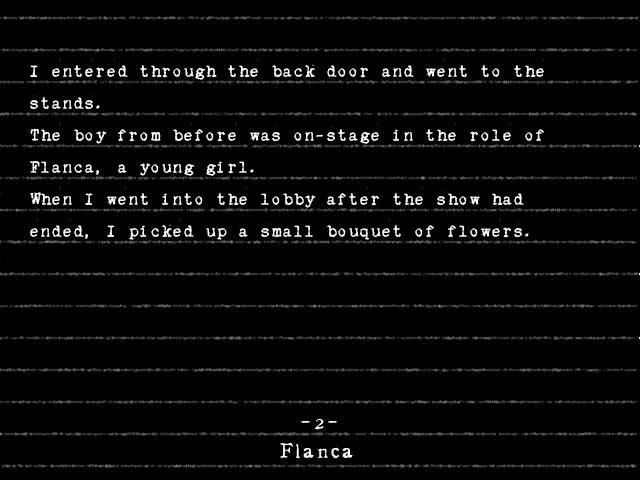
This is one reason that one could argue Flanca is more of a text-based adventure-style game than a visual novel. All I can really say about the visuals is that the text is very neatly presented and readable, avoiding some of the questionable accessibility issues that sometimes crop up in older visual novels (including The Caged Vagrant in I, Too, Saw Dreams Through Air).
Sparse as it is, the style works well with Flanca, which is a dreary, unrelentingly bleak and depressing work.
Music
Here we will only discuss hallucinate since Flanca has no music or sound effects to speak of.
The first half of The world to reverse has a single, haunting background music piece – and it is one of the more memorable of al|together. It is haunting, creepy, slightly distorted, and perfect for what is a haunting, creepy, and distorted piece. The player seems to be stuck in a room with no memories, a missing leg, and a ghostly girl who sometimes appears to taunt him. The background music captures the oppressive feeling. At least one of the four endings comes with a choice sound effect.
Translation quality
As always, I preface my translation review by noting that I do not read Japanese. Thus, I only review how the novels read in English and any obvious or noted discretionary decisions in the translation.
Both hallucinate and Flanca read very well in English, and I will venture that Flanca in particular with its many characters and general vagueness in its parts presented a difficult translation case. One point that impressed me about Flanca is that despite the many characters, I seldom had difficulty figuring out who was talking – even without names being noted or visual aids. I do not recall noting any particularly glaring errors or typos.
Writing and story quality
I will review the two halves of The world to reverse separately since their stories are not related.
hallucinate
The first half of The world to reverse is about the haunting, oppressive, creepy atmosphere. Outside of the one most-revealing ending, the story does not fully show its hand regarding how the player ended up in a hospital bed in an all-white room with one leg missing or why the red-eyed woman hates him. The other three endings do offer some vague information about why the woman hates the player character (not that he can remember), but the full truth only becomes clear in the true end.
There is a trick of sorts in hallucinate, a twist which explains the relationship between the player and the woman. What I describe as the true end makes the clever trick for explaining everything clear (pay attention to the change in title screen). I thought it was clear, at least – but I found some old reviews which suggested some readers missed the proverbial punch-line.
I grant that hallucinate is both atmospheric and clever in the end. However, I will note that the story does not offer much beyond that. There are no large ideas or clear messages at play, and while I can deduce why one particular sequence of choices leads to the true end – there is no greater meaning to it. I see hallucinate as an interesting, perhaps experimental, piece showing some unusual ways to use NScripter. The writing supports what it set out to do well enough.
Flanca
Flanca grew on me as I read through it and began to piece the bleak story together. While hallucinate is creepy and oppressive, Flanca is dark and almost entirely hopeless. Two towns connected by a bridge, a deadly disease spreading through them, desperately poor people, and a theater troupe castrating boys so they can keep playing female roles as eunuchs. No matter what path the player chooses, bleakness likely waits at the end – although there are differences in how badly things turn out for the viewpoint character, a young boy.
Having noted that there is no happy ending in Flanca and there is ultimately little the powerless boy through whom we see the world can do to change the course of affairs, Flanca is a game of exploration. Each series of choices leads to an ending, and most of the endings reveal something new about the world and its characters.
As I write the review, I have not fully solidified my opinion of Flanca’s story and writing. As I read through it, I was curious to try all of the different endings and put the story together – with one ending clarifying something that was only vaguely referenced in another. The five bonus scenes, narrated from the perspective of the major characters instead of the sole view-point character (except for his own bonus scene), contribute more information to understanding the world. The character, or idea, of Flanca plays a role in all of the stories.
While Flanca is interesting for those who are not too put off by the fact that it is almost entirely devoid of hope or optimism (save, arguably, for one of the bonus scenes), I cannot find a greater point to it than learning about its grim world and the different Flancas (to be fair, the Japanese site does note that it does not have a real ending). I plan to read through it again before my final al|together assessment, but my first impression (which includes re-reading a couple of branches) is that there is not much beyond discovering the author’s world and the connection of all of the characters to Flanca (or the character Flanca). By the end you know more about the world, but it is hard to draw any deeper meaning from it. The final statement from the author comes in the extra scene for the view-point character, suggests an overarching message to draw from the disparate stories (I will not spoil it here), but I am not convinced the text of the main game itself delivered it clearly.
Conclusion
The world to reverse is an interesting piece, and I found both halves of it to be fairly high quality. The first half, hallucinate, is notable for its unique visual style and genuinely creepy atmosphere. Flanca is the closest thing in al|together to a choose your own adventure story, one of the few stories with a non-Japanese setting, and without question the darkest al|together story I have read thus far.
I had some issues with hallucinate and Flanca, and I think that Flanca in particular could have done a few things differently, but both are solid and Flanca is, faults and all, a novel which makes one think . I recommend The world to reverse with the caveat that both novels contain dark themes and imagery, some of which I referenced in the review. The 15-plus age note is warranted, and I will further add (take as you will) that the age recommendation stems entirely from text-based content.
The translator, satsu, wrote the following about the piece:
I have very little interest in the usual visual novel crop: I get the impression that it’s a market saturated by twee love games about air-headed cute little girls. (I’m sure this statement will make me very unpopular as well as make everyone aware of my deep ignorance.) Because of this and the fact that I am an outsider to the whole visual novel scene, I felt that I should translate something… different. Something twisted, something macabre, something odd. To that end, I am very pleased to have discovered ‘The world to reverse’.
While I do not fully share Mr. Satsu’s views about visual novels in general (I thought A Winter’s Tale, al|together’s designated true love game, was fairly good), I agree with his take on the work he translated – The world to reverse. It is certainly different, macabre, and odd. In the end, while I am still working out my final opinion of the piece (namely of Flanca), I am pleased to have read and discovered it.